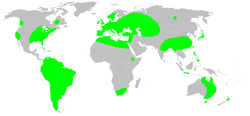Pholcus phalangioides: Difference between revisions
m Reverted edits by Reverejack (talk) to last revision by ClueBot NG (HG) |
Reverejack (talk | contribs) No edit summary Tag: Text added at end of page |
||
| Line 82: | Line 82: | ||
[[vi:Pholcus phalangioides]] |
[[vi:Pholcus phalangioides]] |
||
[[zh:家幽灵蛛]] |
[[zh:家幽灵蛛]] |
||
If you have any questions on this spider, Please contact me at reverejack @ yahoo.com |
|||
Revision as of 05:00, 5 November 2012
| Pholcus phalangioides | |
|---|---|

| |
| With cranefly prey | |
| Scientific classification | |
| Kingdom: | |
| Phylum: | |
| Class: | |
| Order: | |
| Suborder: | |
| Family: | |
| Genus: | |
| Species: | P. phalangioides
|
| Binomial name | |
| Pholcus phalangioides Fuesslin, 1775
| |

| |
The cellar spider or daddy longlegs (Pholcus phalangioides), also known as the skull spider due to its cephalothorax looking like a human skull, is a spider of the family Pholcidae. Females have a body length of about 9 mm; males are slightly smaller. Its legs are about 5 or 6 times the length of its body (reaching up to 7 cm of leg span in females). Its habit of living on the ceilings of rooms, caves, garages or cellars gives rise to one of its common names. They are considered beneficial in some parts of the world because they kill and eat other spiders, including species that are venomous to humans such as hobo and redback spiders.[1][2]
Originally a species restricted to warmer parts of the west Palearctic, through the help of humans this synanthrope now occurs throughout a large part of the world. It is unable to survive in cold weather, and consequently it is restricted to (heated) houses in some parts of its range.
This is the only spider species described by the Swiss entomologist Johann Kaspar Füssli who first recorded it for science in 1775. Confusion often arises over its common name, because "daddy longlegs" is also applied to two other unrelated arthropods: the harvestman and the crane fly.
Pholcus phalangioides has the habit of shaking its web violently when disturbed as a defence mechanism against predators. They can easily catch and eat other spiders (even those much larger than itself, such as Tegenaria duellica), mosquitoes and other insects, and woodlice. When food is scarce, they will prey on their own kind.
Because they originally came from the subtropics, these spiders do not appear to be influenced by seasonal changes and breed at any time of the year. The female holds the 20 to 30 eggs in her pedipalps. Spiderlings are transparent with short legs and change their skin about 5 or 6 times as they mature.
Venom

An urban legend states that Pholcidae are the most venomous spiders in the world, but this claim has been proven untrue. Recent research has shown that pholcid venom has a relatively weak effect on insects.[3] In the MythBusters episode "Daddy Long-Legs" it was shown that the spider's fangs (0.25 mm) could penetrate human skin (0.1 mm) but that only a very mild burning feeling was felt for a few seconds.[4]
References
- ^ Daddy Long Legs – Queensland Museum
- ^ FAMILY PHOLCIDAE – Daddy long-leg Spiders
- ^ Spider Myths – If it could only bite
- ^ "Buried in Concrete, Daddy Long-legs, Jet Taxi". MythBusters. Season 2004. Episode 13. 25 February 2004. Discovery Channel. Retrieved 11 February 2011.
{{cite episode}}: Unknown parameter|episodelink=ignored (|episode-link=suggested) (help); Unknown parameter|serieslink=ignored (|series-link=suggested) (help)
- Ferrick, A. (2002). "ADW: Pholcus phalangioides: Information". Animal Diversity Web. Retrieved 1 March 2007.
- The Near Arctic Spider Database Marine Biological Laboratory, Woods Hole, MA . Accessed August 2008
External links
- Information on the Long Bodied Cellar Spider – often called "daddy long legs"
- Description and pictures
- Long description and pictures
If you have any questions on this spider, Please contact me at reverejack @ yahoo.com
